Cultural Discoveries
The Pei Ligang culture, discovered in 1977, more than 8000 years ago, and the Yangshao culture, discovered in 1921, more than 5000 years ago, are major discoveries in Chinese Neolithic archaeology. New archaeological materials since half a century have proved that these two cultures had a wide distribution in Henan Province, China, and developed in all directions from this center.
The Pei Ligang culture is named after the Pei Ligang site in Xinzheng County, Henan Province, which has been excavated since 1977. In fact, as early as 1958, the remains of Pei Ligang culture were found in the excavation with the fire power plant in Luohe City, but the culture was once classified as Yangshao culture and could not be identified. 1959, a set of stone grinding plates was found in Jiangou, Yanshui, Luoyang, and in 1965, stone grinding plates and sticks were found in Pei Ligang, Xinzheng County. In 1977, the Kaifeng District Cultural Management Committee and the Xinzheng County Cultural Management Committee found a tongue-shaped stone shovel and a clay red pottery amphora in Pei Ligang village, which were initially recognized as prehistoric relics different from the Yangshao culture. In the same year, the above two units then started the first small excavation of the Pei Li Gang site. After that, the second, third and fourth excavations were carried out. The Pei Ligang site and a group of similar sites with distinctive artifact groups, together with the carbon 14 dating of more than 7000 years ago, were recognized as a new cultural type earlier than the Yangshao culture, and the name Pei Ligang culture was proposed around the end of the 1970s. This is the beginning of the exact understanding of the Middle Neolithic archaeological culture in China.
It was first discovered in 1977 in Pei Ligang, Xinzheng County, Henan Province, hence the name. It is mainly distributed in central Henan, and has also been found in northern and southern Henan. The tools of production are mainly ground stone tools, which are exquisitely made, among which the stone sickle with a serrated edge, the long flat double-arc-edged stone shovel and the shoe-sole-shaped quadruped stone grinding plate (with grinding rod) are the most typical, and there are also scrapers made by beating. Pottery to fine clay red pottery and sandwich coarse red pottery, are handmade, firing temperature is low; more plain, a small number of polished or decorated with grate dot pattern; typical shapes are three-legged bowl and half-moon amphora pot. At that time has formed a settlement settlement. The economic life was mainly agriculture, raising pigs, dogs and other domestic animals, and supplemented by gathering and fishing and hunting. It was dated by the carbon 14 method from 5600 to 4900 B.C. It may be the forerunner of the Yangshao culture.
Collapse edit this paragraph Introduction
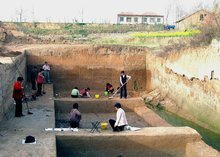
Excavation site of Pei Li Gang culture site
From the excavated artifacts of the archaeological excavation, the local people already knew animal husbandry and farming. They would grow millet in their fields and raise pigs at home. And the local civilization is the earliest pottery civilization known in China nowadays.
The pottery has the largest amount of clay red pottery, accounting for more than 68% of the total pottery, followed by sand-clad red pottery, accounting for more than 28% of the total, and the least clay gray pottery. Pottery are hand-made, most of them are clay strips disc construction. There are fewer decorated objects. Stone tools are mainly ground, with stone shovels, stone axes, stone scythes, stone grinding plates and so on.
The houses are all semi-cavernous, mainly round, but there are also a few square houses with stepped doorways. It is a Middle Kingdom culture of the Neolithic period in the Yellow River Basin of China, named after the earliest excavation and identification of Pei Ligang Village in Xinzheng, Henan Province. The distribution range of this culture is centered on Xinzheng, east to the eastern part of Henan, west to the western part of Henan, south to the Dabie Mountains and north to the Taihang Mountains. According to archaeologists’ identification of the civilization first excavated in 1977, the local culture began in the 5th millennium B.C. on average, with the earliest being as far back as the 8th millennium B.C.
Collapse edit this section Distribution area
So far, more than 100 sites of Pei-Li-Gang culture have been found, distributed in more than 40 counties and cities in Henan Province, with a small number of sites and more than eight or nine sites. Its
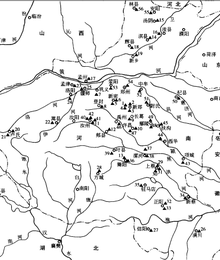
Distribution map of PeiLigang culture sites
Among them, the southern bank of the Yellow River is more concentrated in the central part of Henan, and the shallow hilly areas in the mountains of western Henan and most areas in southern Henan are also distributed. North to Anyang area north of the Yellow River, south to Xinyang area adjacent to Hubei, west to Lu Shi in the upper reaches of Luo River and Xi River, east to Qixian and Xiangcheng areas in Huizi River basin and Ying River basin. The area of Pei Ligang culture sites is not large, small for thousands of square meters, large for 10000 or tens of thousands of square meters, a simple Pei Ligang culture accumulation layer of the average thickness of about 1 meter. If a site contains both Pei Ligang culture, Yangshao culture and Longshan period culture, its area is generally tens of thousands to more than 100,000 square meters, and the cultural accumulation is relatively thick.
Geologically, the vast area of Henan Province is based on the North China Land Platform. Due to the history of geological movement of numerous uplift, resulting in a lot of inter-mountain basin and valley, such as in the west of Henan there are Ilo Basin, Ruying Valley, Qinqin Valley, etc.; east of the Taihang Mountains there is Linxian Basin; east of Songshan, is the Yellow River alluvial plain. Overlooking the entire Central China, everywhere seems to be flat and fertile, but from a small area to observe, there are dense distribution of earth post gullies. The tribes of the Pei Li Gang culture 7,000 to 8,000 years ago lived mostly on the hills near various rivers. The Quaternary loess in this area is widely covered, especially in the East Henan Plain, where the secondary loess accumulated by the Yellow River was very favorable for the development of ancient agriculture. According to meteorological studies, in the middle of the Holocene, 2500-8000 years ago, the annual average temperature in the Central Plains and North China was much higher than today, and the origin of corn farming probably took place here.
The typical sites of Pei Ligang culture are not only Pei Ligang, but also Shawo Li and Tangdu Village in Xinzheng, Xinmi Zugou, Changge Ganghe, Linru Zhongshanzhai, Xuchang Dingji, Jia County Shuiquan, Gong County Tieshenggou, etc. There are no less than 40 sites. Carbon 14 is dated from around 6200 to 5500 B.C., after 700 years of development into the middle Neolithic Yangshao culture.
Collapse edit this section to discover
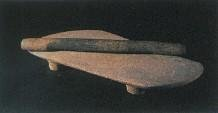
Pei Ligang culture is the archaeological literature of the middle Neolithic period in China and one of the birthplaces of Chinese civilization. after the 1950s, some stone axes, stone shovels and stone grinding wheels were unearthed one after another in the area of Pei Ligang village in Xincheng County. from 1977 to the spring of 1982, archaeologists excavated Pei Ligang, Tang Household and Shawo Li sites in Xincheng County, among which Pei Ligang and Shawo Li Five large-scale excavations were carried out, covering an area of more than 3,550 square meters, clearing 146 burials, 44 ash pits and one pottery kiln, and obtaining 212 pieces of ground stone tools and 299 pieces of pottery. Other excavations included house foundations, caves, bone tools, and plant and animal remains. Archaeologists named this culture as Pei Ligang culture, which was dated around 8000 years ago. From the analysis of cultural relics unearthed at Pei Ligang site, archaeologists believe that the earliest agricultural revolution in China took place here, and the inhabitants of Pei Ligang had entered the stage of hoe farming and were in a matrilineal clan society with primitive agriculture and handicraft industry as the mainstay, supplemented by family rearing and fishing and hunting. It is in the leading position compared with the Magushan culture in Wu’an County of Hebei and the Laoguantai culture in Huayin County of Shaanxi in the same period. Following the excavation of the Pei Ligang sites in Xinzheng County, archaeologists have discovered more than 100 sites of this culture in Henan Province, and in 2001, the Pei Ligang site in Xinzheng City was announced as one of the 100 archaeological discoveries of the 20th century, one of the ten archaeological discoveries of Henan Province, and a national key cultural relic protection unit.
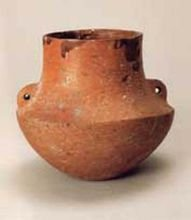
Red pottery small mouth folded shoulder ring bottom double-ear jug
In the 1950s, farmers in the area of Pei Ligang Village, 8 km north of Xinzheng County, kept digging up some stone axes, stone shovels, stone grinding plates, etc. when farming in the fields, not knowing what they were, they were often used to build chicken coops and pig pens, or sit on stones, or discarded everywhere. in the early 1960s, farmers leveled the land and unearthed a large number of stone grinding plates, stone grinding sticks, etc., which began to attract the attention of the archaeological community in Henan Province, only aware of the relics of the primitive social period, but On February 29, 1972, Henan Daily published an article introducing the cultural relics unearthed in Henan Province, including stone grinding plates and rods unearthed in 1965 in Pei-Ligang Village, Xinzheng County, with photos, and generally called them Neolithic relics. In the same year, a lifting and irrigation station was built in Pei Ligang village, and during the construction, some stone tools and many pottery were excavated, which attracted even greater attention from the archaeological community.
Collapse Edit this paragraph Name
In April 1977, the eight tombs excavated for the first time at the Pei Li Gang site and the stone tools, pottery and other artifacts excavated with
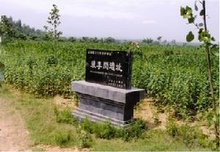
Pei Ligang site culture Yangshao culture period burial style, burial customs and excavated stone tools, pottery and other artifacts were compared and found to have different characteristics, archaeologists initially considered Pei Ligang relics as new ancient cultural remains. 1978, Kaifeng District Cultural Management Committee, Xinzheng County Cultural Management Committee wrote an article “Henan Xinzheng Pei Ligang Neolithic Site” published in the second issue of Archaeology that year, proposing to name Pei Ligang remains as Pei Ligang Culture, but this proposal was deleted by the editorial board of Archaeology. This was considered correct by many archaeologists at that time, because the Pei Ligang site had only been excavated on a trial basis and the archaeological data was not very sufficient. Before the excavation of Pei-Li-Gang site, the site of Magnetic Hill in Wu’an County, Hebei Province, was excavated in 1976, and its information was compared with that of Pei-Li-Gang site, which had both commonality and difference, and some scholars suggested to combine the two sites to name them.
Chen Xu, a teacher of archaeology in the history department of Zhengzhou University, published an article titled “Exploring the origin of Yangshao culture” in the fourth issue of Journal of Zhengzhou University in 1978, arguing that there are commonalities and differences between the cultural landscape and characteristics of the remains of Pei Ligang and Zhongshan, and the commonality is the main one; the commonality indicates that they are the same culture, and the difference indicates that they are cultural remains of different periods; in terms of the overall cultural landscape, Pei Ligang is more developed than Pei Ligang. From the carbon 14 dating, the site of Magnetic Hill is later than the site of Pei-Ligang, so it is considered that
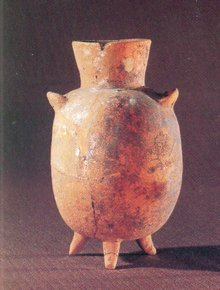
The excavated artifacts Pei Ligang and Magnetic Hill are two different types in the same culture, and it is suggested to be collectively called Pei Ligang culture for the time being, and Pei Ligang type and Magnetic Hill type respectively. After Chen Xu put forward this view, Yan Wenming of the Department of Archaeology, Department of History, Peking University, published an article “New discoveries of the Early Neolithic culture in the Yellow River Basin” in the first issue of Archaeology in 1979, and also believed that “the artifact characteristics of Pei Ligang are more or less the same as those of Jieshan” and “should be classified as an archaeological culture and suggested to be called Jieshan culture”.
In 1980, Xu Shunzhan, the director of Henan Museum, published the article “Trial Discussion on Pei Ligang Culture” in the first issue of Henan Wenbo Newsletter, also believed that the remains of Pei Ligang and Magnetic Hill look similar and belong to the same culture, so they should be called Pei Ligang culture, and Magnetic Hill culture is the successor of Pei Ligang culture. After the 80’s, with the continuous excavation of the remains of Pei Ligang and Magianshan, the archaeological circles studied the remains of Magianshan and Pei Ligang more deeply, and it is more commonly recognized that they belong to two different cultures, and should be called Pei Ligang culture and Magianshan culture respectively.
Folded Editorial Development
About 10,000 years ago, when the Chinese nation as a whole was still in the stage of barbaric history, in the eastern part of Songshan Mountain in the east of the Asian continent, the area centered on Xinzheng, Henan Province, had entered the primitive clan society with primitive agriculture, livestock breeding and handicraft production, supplemented by fishing and hunting. Its main symbol is the Pei Ligang culture of the early Neolithic period.
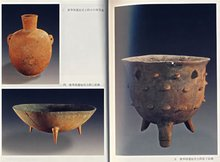
The unearthed cultural relics Pei Ligang culture is named because it was first excavated and identified in Pei Ligang village in Xinzheng, Henan Province. Its distribution range, centered on Xinzheng, extends to Taihang Mountains in the north, Dabie Mountains in the south, east to east Henan and west to west Henan. Many historians and archaeologists believe that a Shaodian clan lived here during the Pei Ligang culture period. They cultivated the hills and terraces with Lei plows, stone axes and stone shovels, planted corn crops, harvested with stone sickles and processed corn grain with stone grinding plates and stone grinding sticks. Date palms and walnut trees were also planted. Pigs, dogs, cows, sheep, deer, chickens, etc. were raised in wooden fences and caves. They use fish darts and bone clusters to engage in fishing and hunting production. They built many pottery kilns to fire bowls, jars, cups, pots, pots, urns, basins, retorts, bowls, spoons, tripods, etc. They fired pottery pig’s head, pottery sheep’s head and pottery human head and other artworks with realistic images. They were no longer living a nomadic life as many ancient books as well as some modern scholars say. They lived in single-room, double-room, three-room or four-room thatched huts in the hillock near the river. The men plowed the fields, hunted, and fished; the women processed grain, raised livestock, and brought their children home to cook on the stove with pottery vessels such as tripods, and to make ramie-like clothes with pottery spinning wheels and bone needles. In addition to production, they had a simple cultural life, carving symbolic primitive writing on turtle nails, bone tools and stone tools to remember things, and placing fired pottery artifacts on the table for viewing. During the break, the men picked up the stone and pottery pieces and accompanied by the seven-hole bone flute, which was quite accurate; the women were dressed up, with their hair combed in high buns, with bone matrices on their heads, and with bone ornaments and pine and green stones on their bodies, dancing joyfully to celebrate the harvest or any happy event. They had a public clan cemetery, and when children died, they were buried in urns, and when adults died, they were buried with their heads to the south and feet to the north regardless of gender, and they were also buried with production tools or household utensils according to their merits (rich or poor) and gender. This is the oldest civilization of the Central Plains.
Collapse edit this paragraph cultural significance
Pei Ligang culture, whether in terms of productivity or culture and art, is in the leading position in this large area of ancient China, compared with the Magyama culture in Hebei and the Dadiwan culture in Gansu in the same period. Archaeologist Zhao Shigang said in his “Discussion on some issues of Pei Ligang culture”:- “The crescent-shaped zone in West Asia and the eastern foothills of Songshan Mountain in China, like two lighthouses juxtaposed in the east and west, appeared in both wings of Asia in the same period as far as eight thousand years ago, marking the dawn of a new era of ‘agricultural revolution’ in the eastern hemisphere.” In his “A New Inquiry into the Origins of Chinese Civilization,” the mnemonic archaeologist Su Bingqi proposed that China is “a cultural root system of more than a million years, a civilizational beginning of tens of thousands of years, an ancient state of five thousand years, and a unified Chinese entity of two thousand years.” Archaeological data show that the Pei Ligang culture in the Central Plains was about 10,000 years old and was the most advanced culture in the early Neolithic period. Mr. Su’s “the beginning of civilization in the last ten thousand years” should refer to the culture of Pei Ligang.
Pei Ligang culture, like other types of early Neolithic cultures in northern China, has fine stone remnants, indicating that it has a relationship with the Mesolithic remains represented by Henan Lingjing and Shaanxi Shayuan. It has a closer relationship with the later Yangshao culture in terms of architectural remains, burial practices, agricultural production, especially pottery forms and ornaments, etc. It is generally believed that the Hougang type of Yangshao culture is the inheritance and development of the Pei Ligang culture and the Magyama culture. Pei Ligang culture is the predecessor of Yangshao culture together with Laoguantai, Lijiacun and Magianshan cultures, so it is collectively called the “former Yangshao” period new period culture.
Collapse edit this paragraph mystery
The Pei Ligang culture is a middle Neolithic culture of 8,000 years ago, and its discovery has painted the ancient civilization of China with a unique layer of magic and mystery, making our archaeologists and explorers fascinated by it. Obviously, at the dawn of human civilization, the Pei Ligang people already had the extraordinary ability to use their clumsy hands and their extremely limited wisdom during the transition from apes to humans to overcome the harsh natural environment, to establish ancient clan villages, and to present the glorious and splendid ancient civilization they created as a precious gift to their descendants for generations to come.
Pei Li Gang culture is a great civilization created by the ancestors of the Central Plains alone, and it has made great contributions in the development process of ancient Chinese civilization, whether in science, agriculture or culture, art and many other aspects. It can be said that in this vast land of China, the civilization created by Pei-Ligang people is extremely important and decisive in the history of human development. Pei Ligang culture, with a certain unique spiritual outlook, is very different and interesting from the Yangshao culture of the later period. What kind of history does its discovery indicate to people?
This ancient land has indeed a remarkable outlook and experience that leaves a very deep impression. About 7,000 years ago, the soil here was quite fertile, covered with grass and trees, and rich in water, which is why the ancestors chose to live here and lead a relaxed life. Standing on the ridge of the hill, from east to west, the site falls from high to low, through a slow slope and the raging water of the Shuangqin River. Cook River and the Qin River in the northern part of Pei Li Gang convergence, southward flow through the western part of the site, and then immediately south of the site to the east, where the formation of a river bay, the site is surrounded by the northeast bank of the bay on the terrace. The site zigzagged 4 to 5 meters above the surrounding ground and about 25 meters above the riverbed. According to archaeologists, the landscape should have been different from the present one, and the water source may have been closer to the edge of the site, facilitating the drinking and agricultural use of the original people. The site is long and narrow from northwest to southeast, while narrower from east to west, with a total area of 20,000 square meters.
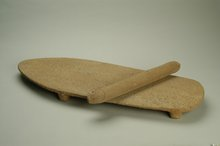
This is a secret forbidden place of early human civilization. The thick green wheat seedlings, undulating with the wind, and the occasional sunlight that breaks through the clouds shining in the wheat fields, shining with a green glow, reflecting the brown soil under our feet, make people feel strongly a solemn and mysterious atmosphere. Although the place has been washed by thousands of years of wind and rain, and the relics of early civilization have been submerged underground, no force can change the eternal history and the existence of Pei Li Gang people. Nor will it disappear forever in the black hole of the vast history, it will lose no time to show its existence to mankind.
As early as the early 1950s, Pei Li Gang villagers often found some peculiarly shaped stone grinding plate, stone grinding rod, stone shovel, stone axe, pottery pot and other things when leveling the land, so they moved these ancient relics home as a pounding stone, laundry board or used to pad the pigpen, the wall ……
The initial discovery of the stone mill plate, a situation was washed out by the pouring rain, another is the farmers plowing from the ground turned out, and then the farmers leveling the land, take the soil dug out. And no one has ever thought about what it really is and why these strange things are born in the ground, much less that it is the cultural essence left behind by a great vanished civilization. It never stops chanting the spirit of its time, and the profound ideas it contains are beyond the comprehension of modern man, and it is doomed to wait until someone can master the key to crack the code before it can reappear in its true form.
The discovery of the stone mill plate, which gradually attracted the attention of the cultural relics community, is a relic of the late primitive society, a production tool for grinding grain, but no specific era is stated. The shape of the stone mill plate is like a long stone plate, while the two ends are rounded, like the sole of a shoe. It is made of whole sandstone, and the front side is slightly concave, probably caused by long-term use. Most of the stone grinding plates have four cylindrical legs at the bottom of the plate, which are 3 to 6 cm high. Stone grinding plate is generally about 70 cm long, the longest up to 1 meter, the width is generally 20 cm to 30 cm. With its supporting use is the stone grinding rod, its length is generally about 30 cm to 40 cm, about 6 cm in diameter. It is inconceivable that 7,000 years ago, in such a distant era, humans were able to use whole stone plates to grind processing tools for grain hulling, and what is even more incomprehensible is why this production tool, which unites the high intelligence of primitive humans, suddenly and mysteriously disappeared in its later cultural layers? What was the reason for this?
Soon, “Henan Daily” reported such a news: Xinzheng Pei Li Gang village in the leveling of the land, a dozen sets of stone grinding plate found, these stone grinding plate by the faceted and made, the plane is wide in front and narrow oval, slightly shoe-like, the bottom of the plate with a columnar foot. So what period are these exquisite stone grinding plates from? What kind of archaeological culture do they belong to? Why are they concentrated in Pei Li Gang Village? These questions have attracted widespread attention and attention from the archaeological community. Archaeologists began to focus their attention on this small and inconspicuous village, and began to tirelessly explore and study the cultural content hidden in these stone grinding plates and sticks.
In the fall of 1975, Li Cheming, a member of the West River Lee production team of the Yunwan Brigade, found a stone grinding wheel and a stone grinding stick when plowing the land in Pei Li Gang. The stone grinding plate stood on its side next to the skeleton of the tomb owner, and the stone grinding rod was placed on the two legs of the stone grinding plate. Soon Pei Li Gang production of the southern team of community members Li Nonin found two pieces of stone grinding plate in the post when taking soil, are flat in the tomb room, no stone grinding rod was found. Then the West River Lee community member Li Zengtai in the ridge of the post when plowing found a stone mill plate, standing on its side in the cemetery, stone mill stick aside, next to the stone mill plate also placed a pottery jar, the jar is full of “pebbles”. According to the survey, from 1959 to 1977, when the stone grindstone was declassified, more than 40 pieces were found.